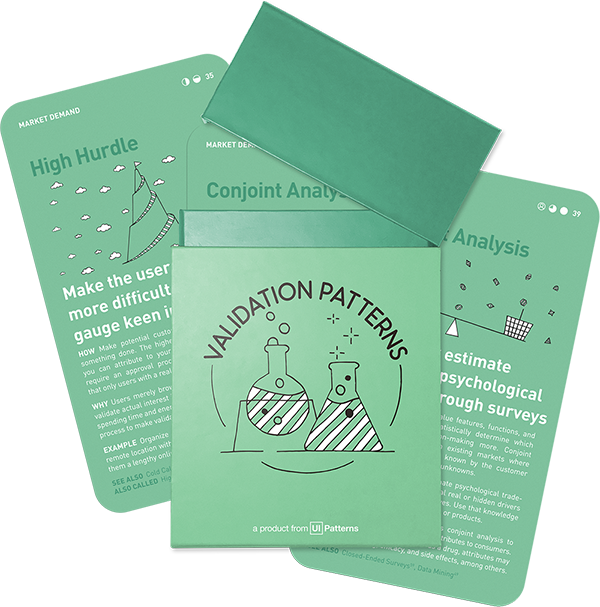Idea Validation: Problem, Market demand
Five People Who Are In
If you cannot find five, your market is too small or too hard to reach

How: Find 5-10 potential customers who agree with your proposed problem or see your product as solving significant pain points.
Why: Finding at least five people acknowledging their keen interest in using your hypothetical product provides a sensible indication that you have a problem worth solving.
Early stage market validation
Once you’ve decided on a specific market for your product, a first simple experiment to run is finding five people who are in that market segment. If you this isn’t faily easy, you have either picked a market segment too small, one that is too hard to reach, or you are just approaching it wrong. To correct your approach, find someone with market knowledge to help you.
Even though this won’t provide solid proof of market size and readiness, it can still help correct your efforts in the right direction in the very early stages.
It’s five people instead of one for a reason. By setting the clear target of five (or more), you are forced to not only reach out to your close friends and collegeaus, but also to strangers. That is the goal: to get out of the building in the wild to talk to somebody who you haven’t already preached to.
Find the watering hole and observe context
Go Find the watering hole if the people you identified are nearby. Visit them in the context of where you expect them to use your product: at the office, in their homes, at the tennis court. If the people you have identified aren’t nearby, see if you can have a session on Skype, FaceTime, Hangouts, or such, and do a screenshare if that will help them show you how they are currently solving the problem in question.
If you have the opportunity, perform a Contextual Inquiry. Ask them to show you how they currently perform tasks relating to the problem you are trying to solve. Ask them to run you through exactly how they go about completing the tasks and inquire as to what other solutions they have tried.
Can you spot patterns of behavior? Are they specific problems that reoccur between other participants? Did they all complain about the same thing or unknowingly performing tasks in a specific way that you can help make easier?
Don’t force your perspective
The greatest mistake you can make with this experiment is to start off an interview by telling the participant about what you are working on and how it’s going to transform his world. That is the sure way to plant a strong bias. Everything the participants tells you from that point on will be distorted by your perspective - not his. You are not there to talk, but to listen.
Real life Five People Who Are In examples
Drip
Rob Walling, founder of email-marketing tool Drip, initially sought out 10 people who were willing to pay for his final product. It forced him to distill the idea down to its core value proposition. Emailing 17 people in his network, he found initial customers who could provide feedback on how the future product should be developed. He used the early base of revenue to start growing the product.
Source: The Lean Validation Playbook
A collection of 60 product experiments that will validate your idea in a matter of days, not months. They are regularly used by product builders at companies like Google, Facebook, Dropbox, and Amazon.
Get your deck!Related plays
- The Lean Validation Playbook by Hanno
- UX for Lean Startups by Laura Klein by Laura Klein

